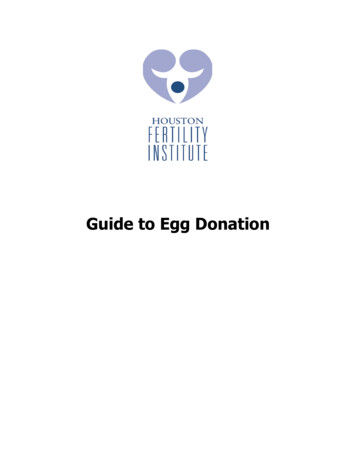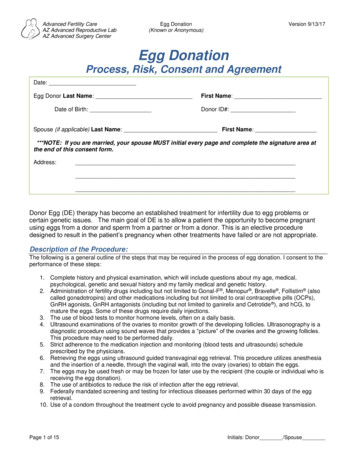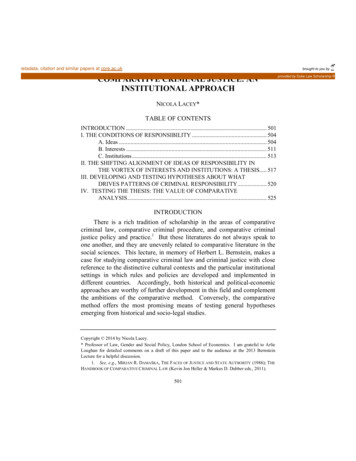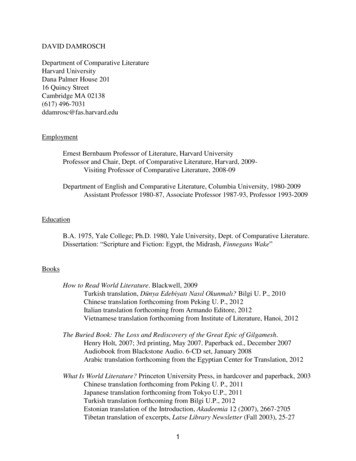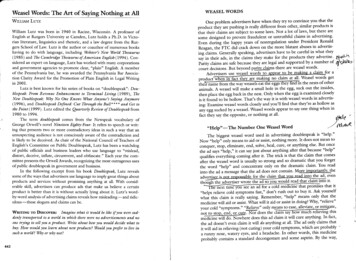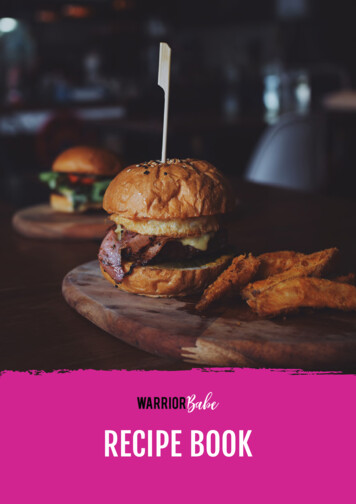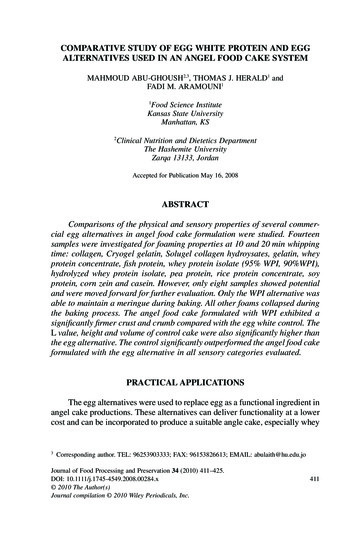
Transcription
COMPARATIVE STUDY OF EGG WHITE PROTEIN AND EGGALTERNATIVES USED IN AN ANGEL FOOD CAKE SYSTEMMAHMOUD ABU-GHOUSH2,3, THOMAS J. HERALD1 andFADI M. ARAMOUNI11Food Science InstituteKansas State UniversityManhattan, KS2Clinical Nutrition and Dietetics DepartmentThe Hashemite UniversityZarqa 13133, JordanAccepted for Publication May 16, 2008ABSTRACTComparisons of the physical and sensory properties of several commercial egg alternatives in angel food cake formulation were studied. Fourteensamples were investigated for foaming properties at 10 and 20 min whippingtime: collagen, Cryogel gelatin, Solugel collagen hydroysates, gelatin, wheyprotein concentrate, fish protein, whey protein isolate (95% WPI, 90%WPI),hydrolyzed whey protein isolate, pea protein, rice protein concentrate, soyprotein, corn zein and casein. However, only eight samples showed potentialand were moved forward for further evaluation. Only the WPI alternative wasable to maintain a meringue during baking. All other foams collapsed duringthe baking process. The angel food cake formulated with WPI exhibited asignificantly firmer crust and crumb compared with the egg white control. TheL value, height and volume of control cake were also significantly higher thanthe egg alternative. The control significantly outperformed the angel food cakeformulated with the egg alternative in all sensory categories evaluated.PRACTICAL APPLICATIONSThe egg alternatives were used to replace egg as a functional ingredient inangel cake productions. These alternatives can deliver functionality at a lowercost and can be incorporated to produce a suitable angle cake, especially whey3Corresponding author. TEL: 96253903333; FAX: 96153826613; EMAIL: abulaith@hu.edu.joJournal of Food Processing and Preservation 34 (2010) 411–425.DOI: 10.1111/j.1745-4549.2008.00284.x 2010 The Author(s)Journal compilation 2010 Wiley Periodicals, Inc.411
412M. ABU-GHOUSH, T.J. HERALD and F.M. ARAMOUNIprotein isolate (WPI). These results may help producers in formulating anglecake that rely on WPI as an egg alternative.INTRODUCTIONAngel food cake is traditionally made by combining an egg whitemeringue with flour and sugar to form a batter that is baked to form a solidfoam cake. Egg white is composed of a variety of proteins that range inchemical properties (molecular weight, pI, glycosylation, phosphorylationand sulfhydry/disulfide content) (Lin-Chan et al. 1989). Not all individualegg white proteins have the ability to function in making angel food cake.Ovalbumin (54% of total protein) and globulins (8% of total protein), whentested individually, are the only two that produce angel food cakes withvolume equal or greater than egg white (Johnson and Zabik 1981a,b; LinChan et al. 1989).Commercial egg alternatives available for application in bakery productsare marketed as considerable long-term cost savings. The partial replacementof egg white protein (EWP) with cheese whey protein concentrates (WPC) orwhey protein isolate (WPI) in angel food cake formulations has been reportedpreviously (Morr et al. 1973; Haggett 1976; Khan et al. 1979; Morr and Han1993; Lawson 1994; Zhu and Damodaran 1994; Arozarena et al. 2001). Theexcellent foaming and heat-induced gelation properties of commercial WPI(Morr and Foegeding 1990; Philips et al. 1990; Morr 1992) and lipid andcalcium content-reduced WPC prepared from pretreated and microfilteredwhey (Karleskind et al. 1995a,b,c) suggested that they might be used toreplace EWP in angel cake formulations. Arunepanlop et al. (1996) investigated the effect of replacing 25 and 50% of liquid egg white with WPI solutionin angel food cakes. Patino et al. (2007) found that the foaming capacityincreases by increasing the sunflower protein concentration and its hydrolysates in solution. Foams retain a higher amount of liquid, are denser and thebubbles are smaller when the protein concentration increases. The foam stability also increases with the amount of protein in solution. Therefore, theseproteins might be used to replace EWP in angel cake formulations.With the advent of new technologies, many new food ingredients arebeing advertised. However, there is very little literature that compares theseingredients with eggs in a scientific study. The hypothesis of this study iswhether egg alternatives may replace egg as a functional ingredient in angelfood cake system. The objective was to evaluate the physical and sensoryproperties of the angel food cake systems formulated with either egg or eggalternatives.
EGG ALTERNATIVES IN ANGEL FOOD CAKE413MATERIALS AND METHODSThe ingredients used in all angel food cake formulations included ionizedsalt (Kroger Co., Cincinnati, OH), pure cane sugar (C&H Sugar Co., Crockett,CA) and corn oil (Kroger Co).The egg and egg alternatives evaluated in the angel food cake formulawere either donated or purchased. They included: pasteurized liquid egg yolkpurchased from Cutler Egg Products (Abbeville, AL), collagen (Great Lakes,Magnolia, AR), Cryogel gelatin (CG) and Solugel collagen hydroysates (SCH)(PB Gelatins, Carlsbad, NM), gelatin (Rousselat, Dubuque, Iowa), wheyprotein concentrate (WPC) and fish protein (FP) (Parmalat Ingredients,Ontario, Canada), 90% whey protein isolate (90% WPI), 95% whey proteinisolate (95% WPI), hydrolyzed whey protein isolate (HWPI) (Davisco International, Eden Prairie, MN), pea protein (PP) (Parrheim Foods, Manitoba,Canada), rice protein concentrate (RPC) (A&B ingredients, Fairfield, NJ), soyprotein (ADM, Decatur, IL), corn zein and casein (Sigma, St. Louis, MO).Foaming Property TestFourteen samples were investigated for foaming properties at 10 and20 min whipping time. Foam capacity and stability were measured using amodified method of Philips et al. (1990). Three replication and three subsamples per replications were performed on nine different treatments. Foamcapacity and stability were measured after whipping/aerating a 150 mL of a12% protein solution (w/v) for 10 or 20 min in a Kitchen Aid Mixer (KitchenAid, St. Joseph, MI) at approximately 100 W. The drainage was measuredevery 5 min for 30 min using a funnel and a graduated cylinder apparatus atroom temperature. However, we included only the drainage results for 10, 20and 30 min because they clearly demonstrated the most significant change.Batter and Cake PreparationAngel food cake was used as a system to compare and evaluate thefunctionality of the egg alternatives relative to the egg white protein. A commercial angel food cake formulation (Table 1) was modified for the study. Theblended protein solutions were whipped 1 min at speed setting 8 with an UltraPower Mixer Model KSM90AC (Kitchen Aid Portable Appliances) equippedwith a wire whisk attachment.A Reed reel oven (Reed Oven Co., Kansas City, MO) was preheated to375 F (190.5C), during which time a pan of water was placed in the oven forconditioning. For the experimental angel food cakes being baked and evaluated, the pan of water was removed prior to checking the first test cake toensure proper baking conditions.
414M. ABU-GHOUSH, T.J. HERALD and F.M. ARAMOUNITABLE 1.A COMMERCIAL ANGLE FOOD CAKE FORMULATIONIngredient(g)% (flour basis)FlourSugarDried egg white/proteinMonocalcium phosphate, 6.41.42.7268.0About 18 h before baking either the reconstitute egg white or egg alternative was mixed in requisite amount of water with in a Kitchenaid mixer(Model K5-A, Hobart Corp., Kitchenaid Div., Troy, OH) using a whip attachment on low for 5 min. The mixtures were covered and stored at 4C overnight.The following day, either the egg white or egg alternative solution was transferred to a to a Hobart A-100 12 quart mixer, and the remaining dry ingredients(sodium chloride, monocalcium phosphate and one-half of the sugar) wereadded and blended. The blending was done with the egg protein or eggalternative mixture at low speed for 1 min or until a homogeneous solution wasobtained. Then, the mixture was blended on the highest mixer setting until thespecific gravity of the mixture was between 0.14 to 0.13. The specific gravitywas determined by the weight comparison method 10-14 (AACC 1983).The cake flour was sifted, combined and mixed at low speed with theremaining sugar for at least 20 s. The flour–sugar mixture was folded bydipping the whip into the batter and was shacked off 10 times and then pouredinto aluminum pans. Aluminum pans were filled with 650 g batter and bakedfor 55 min at 375F (or until the surface of cake springs back when lightlytouched). Then cakes were cooled in an inverted position on a wire rack for40 min, and the cake volume was determined.Cake ColorCrumb color was measured using a Hunter Miniscan portable colorimeter(HunterLab, Reston, VA). The colorimeter was calibrated using a light trap andwhite tile according to procedure set forth by the HunterLab owner’s manual.Color was measured using natural light (C) at a 10 angle. Three measurements of each sample were taken and then averaged. The L, a and b valueswere all recorded. These angle cake color attributes can be defines as thefollowing: (lightness [L], yellowness to blueness [b], and redness to greenness[a]). Procedures for color were adapted from Lee et al. (1991).
EGG ALTERNATIVES IN ANGEL FOOD CAKE415Cake VolumeCakes volume was determined 1 day after baking by American Association of Cereal Chemists (AACC) Baking Quality Method 10-91 (AACC2000). Two cakes were each sliced into two similar-sized halves. The indextemplate was placed up against the cut edges of the cakes, and the height ofdesignated positions B, C and D were recorded. These recorded heights wereused to compute volume as instructed in AACC (2000) method 10-91. Volumeis computed by B C D. Measurements were then averaged.Texture AnalysisCake firmness was determined with TA-XT2 Texture Analyzer (TextureTechnologies, Scarsdale, NY) equipped with a 25-kg load cell. The angel foodcake sections were compressed to 60% of the original height using a 20-mmcylindrical probe in the TPA mode (two-compression test) with a 15 s delaybetween compressions. Results were analyzed with the aid of a XTRADcomputer program and presented as a force versus time graph with a 15-g forcethreshold setting. The (8 in.) angel food cake was longitudinally sliced toobtain two halves. The crust and crumb were evaluated for firmness. Individualhalves were probed in five randomly selected locations around each half. Thisprocedure was performed on three cakes per treatment. The firmness of eachmeasurement was recorded. Cakes were tested within 24 h after baking. Measurements were taken by using the following setting: test mode: texture profileanalysis (T.P.A.), pretest speed: 3 mm/s, test speed: 1.7 mm/s, posttest speed:1.7 mm/s, distance: 6 mm, trigger: auto at 20 g, acquisition rate: 200 pps.Sensory AnalysisCakes were evaluated within 2 days after being baked using a completeblock design to randomize the order of evaluation. After cooling and depanning, cakes were cut into 1.5-cm radial sections, placed in plastic freezer bags,sealed and stored at 23C until they were subjected to sensory analysis. Evaluations were performed by 100 untrained sensory panels that are at least 18years old. Panelists were prescreened for potential food allergies and on thebasis of being an angel food cake consumer. Panelists were provided with aninstruction/score sheet with specific instructions for evaluating the samples.Angel food cake samples were offered to panelists on odorless plastic platescoded by three-digit random numbers at room temperature. Samples wereserved to panelists monadically. The order of serving was determined byrandom permutation. Questionnaires were provided with samples. Panelistswere instructed to use unsalted crackers and distilled water to cleanse theirpalate before tasting the samples and any time during the test as needed. The
416M. ABU-GHOUSH, T.J. HERALD and F.M. ARAMOUNIpanelists evaluated angel food cake on a 9-point hedonic scale to determinedegree of liking of the cake (9 like extremely, 5 neither like nor dislike,1 dislike extremely). The samples were rated for aroma, taste, texture andoverall acceptability on the same scale.Statistics AnalysisThree replications and three subsamples per replication were performedon nine different treatments. Treatments were compared for their physical andsensory characteristics following a one-way completely randomized design.The analysis of variance (ANOVA) and means comparison were conducted bythe general linear model (Proc GLM) and ANOVA (Proc ANOVA) procedureswith Statistical Analysis System software (version 8.2, SAS Institute, Inc.,Cary, NC). Comparisons among treatments were analyzed by using Fisher’sleast significant difference, with a significance level of P 0.05.RESULTS AND DISCUSSIONFoaming PropertyCommercial egg alternatives available for application in bakery productsare marketed as considerable long-term cost savings. These egg alternativesare advertised to possess useful functional properties, including: browning,cohesiveness, foaming, gelling water binding and emulsifying attributes.There were many stages of screening for egg alternatives to be consideredfor use in angel food cakes. The initial screening was the ability of the eggalternative to form stable foam. The next screening consideration was theability of the stable foam to be baked under processing conditions (temperature and time) that would be used in the production of angel food cake.Therefore, only the egg alternatives that passed the baked meringue test wereused in the final experimental design. Only the egg alternatives that exhibit anacceptable foam property performance level as deemed by the evaluators weredesignated for use in the angel food cake model system study.Fourteen egg alternatives and an egg white protein were evaluated andinvestigated for foaming properties. Only eight showed potential and weremoved forward for further evaluation (Tables 2 and 3). The suppliers advertisetheir products for use as egg white protein alternatives. Figures 1 and 2 provideimages of selected egg alternatives and their foam capacity and stability.Therefore, one may observe the range of foaming functionality that theseselected egg alternatives possess. Tables 2 and 3 exhibited differences in foamcapacity and stability as a function of mixing time. This experiment wasconducted to determine if egg alternatives needed a different mixing time to
EGG ALTERNATIVES IN ANGEL FOOD CAKE417TABLE 2.COMPARISON OF FOAM CAPACITY AND STABILITY BETWEEN EGG WHITE PROTEINAND EGG ALTERNATIVES AFTER MIXING FOR 10 MINTreatmentSpecific gravityTime (min)1020302.19 0.5800.00 0.000.00 0.002.465 3.48614.09 1.9900.065 0.0927.69 0.4102.044 0.4273.285 0.1630.00 0.000.00 0.003.98 4.31014.46 1.4700.29 4.108.8 0.5663.389 0.155Drainage (mL)Egg whiteCGCollagen95% WPIWPC90% WPIGelatinHWPI0.078 0.0140.299 0.0010.266 0.0500.088 0.0420.155 0.0130.117 0.0210.096 0.0050.039 0.0050.905 1.1240.00 0.000.00 0.000.85 1.2039.76 1.5000.00 0.004.84 0.3390.00 0.00CG, Cryogel gelatin; WPI, whey protein isolate; WPC, whey protein concentrate; HWPI, hydrolyzedwhey protein isolate.TABLE 3.FOAM CAPACITY AND STABILITY WHEN MIXED FOR 20 MINTreatmentSpecific gravityTime (min)1020304.40 0.188N/AN/A0.000 0.00015.506 0.5020.000 0.0008.4 0.6080.378 0.4025.40 0.188N/AN/A1.967 0.04115.883 0.4690.000 0.0009.767 0.6431.90 0.506Drainage (mL)Egg whiteCG*Collagen*95% WPIWPC90% WPIGelatinHWPI0.093 0.004N/AN/A0.040 0.0010.114 0.0090.055 0.0010.108 0.0050.312 0.0022.334 0.566N/AN/A0.000 0.00013.350 0.4940.000 0.0004.867 0.2080.00 0.00* No foam formed; instead, a gel-like substance was formed.CG, Cryogel gelatin; N/A, not applicable; WPI, whey protein isolate; WPC, whey protein concentrate;HWPI, hydrolyzed whey protein isolate.enhance their foaming properties compared with egg white protein (Fig. 3). Itwas found that 95% WPI and gelatin foams exhibited similar foam density toegg whites (Table 2). CG, collagen, WPC and 90% WPI had a greater specificgravity. However, only CG, collagen and 90% WPI had longer foam stabilitycompared with egg white foams. Ninety-five percent WPI and HWPI hadrelatively similar foam stability at 30 min drainage. WPC had both poor foam
418M. ABU-GHOUSH, T.J. HERALD and F.M. ARAMOUNIABCDEFIG. 1. REPRESENTATIVE IMAGES COMPARING FOAMS PREPARED WITH EGGWHITE AND SELECTED FOAMING EGG ALTERNATIVES(A) egg white, (B) casein, (C) whey protein isolate (WPI), (D) Parmalat whey proteinconcentrate (WPC), and (E) 90% WPI.CABBCFIG. 2. REPRESENTATIVE IMAGES COMPARING FOAM STABILITY OF(A) PARMALAT WHEY PROTEIN CONCENTRATE (WPC), (B) EGG WHITE AND(C) WHEY PROTEIN ISOLATE (WPI)density and stability. gelatin had similar foam density to egg white, but lesserdrainage capacity. CG and collagen did not form foams; instead, they formeda gelatin-like substance. Ninety-five percent WPI and gelatin exhibited similaror better specific foam capacity than fresh egg white.Many of the egg alternatives were able to produce a stable foam (Fig. 4),although the specific gravity did vary form one protein source to the next.Based on the foaming data, the whey protein sample (WPI, 90 and 95%)exhibited potential to make an acceptable angel food cake compared with theother egg alternatives evaluated.MeringuesPreliminary data showed that not all egg alternatives that performed wellin the foaming study could withstand the high temperatures (375F/30 min)
EGG ALTERNATIVES IN ANGEL FOOD CAKE419ABCFIG. 3. REPRESENTATIVE COMPARISON OF FOAM CAPACITY AND FOAMSTABILITY OF SELECTED EGG ALTERNATIVES(A) egg white, (B) gelatin and (C) collagen.required to bake an angel food cake. Prior to preparing all the foams for caketesting, a series of baked meringue were evaluated. Only the egg alternativesthat successfully were able to deliver a baked meringue were considered fortesting in the angel food cake experiments. Below are images that depicted thesuccess of the egg alternatives in a baked meringue experiment (Fig. 5). Onlythe 95%WPI egg alternative was able to maintain a meringue during baking.All other foams collapsed during the baking process, and representativesamples are depicted in Fig. 6. The angel food cake formulated with 95% WPIexhibited a significantly firmer crust and crumb compared with the egg whitecontrol (Fig. 7).
420M. ABU-GHOUSH, T.J. HERALD and F.M. ARAMOUNIProtein10 mi n20 minFresh Egg WhiteCGCollagen95%WPIWPC90%WPIGelatinHWPIFIG. 4. DEPICTION OF EGG WHITE AND EGG ALTERNATIVE FOAMS AFTER10 AND 20 MIN OF MIXING
EGG ALTERNATIVES IN ANGEL FOOD CAKEProteinBe for e421A f te rFresh Egg WhiteWPC95%WPICollagenFIG. 5. DEPICTION OF MERINGUES OF EGG WHITE AND EGG ALTERNATIVESBEFORE AND AFTER BAKING AT 375F FOR 30 MINL ValuesThe L value of the angel food cake formulated with egg white proteinexhibited a significantly higher L value compared with the WPI (Table 4). Thea and b values of angel food cake formulated with egg white protein had alower value compared with 95%WPI.VolumeData showed that replacing eggs with a single ingredient did not producevolumes close to that of cakes with eggs (Table 4). The control cake’s height
422M. ABU-GHOUSH, T.J. HERALD and F.M. ARAMOUNIFIG. 6. REPRESENTATIVE IMAGE OF AN ANGEL FOOD CAKE FORMULATED WITH ANEGG PROTEIN ALTERNATIVE TREATMENT (COLLAGEN) THAT DID NOT MAKE THESCREENING BECAUSE OF UNACCEPTABLE QUALITYEgg protein95%WPIFIG. 7. REPRESENTATIVE IMAGES OF ANGEL FOOD CAKES PREPARED WITH EGGWHITE PROTEIN AND WHEY PROTEIN ISOLATE (95% WPI)TABLE 4.COMPARISON OF SELECTED PHYSICAL ATTRIBUTES OF ANGEL FOOD CAKESFORMULATED WITH EGG WHITE PROTEIN OR WHEY PROTEIN ISOLATETreatmentsColorL*Control95% WPIa*80.96 5.9563.11 2.83BAHeight (cm)Volume (cm3)8.55 0.28A4.53 0.43B3,193.23 131.55A1,411.45 212.55Bb*2.40 1.6514.04 4.82B17.42 2.19B35.79 7.04AAverage SD. Means followed by the same superscript letters in the same column are not significantlydifferent (P 0.05).WPI, whey protein isolate.
EGG ALTERNATIVES IN ANGEL FOOD CAKE423TABLE 5.COMPARISON OF ANGEL CAKE FIRMNESS OF ANGEL FOOD CAKE FORMULATEDWITH EGG WHITE PROTEIN AND WHEY PROTEIN ISOLATETreatmentsCrust firmness (g-force)Crumb firmness (g-force)Control (egg white)95% WPI35.83 2.87217.49 93.09A38.12 3.43B461.05 172.96ABAverage SD. Means followed by the same superscript letters in the same column are not significantlydifferent (P 0.05).WPI, whey protein isolate.TABLE 6.CONSUMER SENSORY OF ANGEL FOOD CAKE FORMULATED WITH EGG WHITEPROTEIN OR WHEY PROTEIN ISOLATESensory vor/tasteAcceptabilityWilling topurchase (%)Control95%WPI7.14 1.37A5.85 1.85B7.19 1.60A5.54 2.00B6.99 1.54A5.91 2.11B7.21 1.35A5.61 1.95B80.242.3Average SD following a hedonic scale of 1–9 (1: dislike extremely, 5: neither like nor dislike, 9: likeextremely). Means followed by the same superscript letters in the same column are not significantlydifferent (P 0.05).WPI, whey protein isolate.and volume were also significantly higher than the egg protein alternative.Cake volumes were still significantly less than control cakes for 95% WPIalternative. These results were similar to those of Arunepanlop et al. (1996)and Pernell et al. (2002).TextureTexture was affected by replacing eggs with other ingredients. Hardnessdata showed that treatment containing 95% WPI had significantly highervalues than control (Table 5). At 95% WPI replacement, crust and crumbfirmness were 217.49, 461.05 (g-force) for treatment, respectively, whereas35.83 and 38.12 (g-force) for control.Consumer PanelThe control significantly outperformed the angel food cake formulatedwith the egg alternative in all sensory categories evaluated (Table 6). Thesensory data supported the physical data.
424M. ABU-GHOUSH, T.J. HERALD and F.M. ARAMOUNIConsumers found that the cake formula control was significantly morefavorable than the 95% WPI cake in appearance, texture, flavor and overallacceptability (Table 6). It is expected that 95% WPI was exposed to differentprocessing conditions and pretreatments that may affect its functions as an eggalternative. Consumers stated that they would be more willing to buy thecontrol formulation than the WPI alternative. Only 42.3% of consumer statedthey would be willing to purchase the cake formulated with WPI alternative.CONCLUSIONMany of the egg alternatives were able to produce a stable foam.Although the specific gravity did vary from one protein source to the other.Based on the foaming data, the whey protein sample exhibited potential toproduce an acceptable angel food cake compared with the other egg alternatives evaluated. The egg protein alternative did not perform as well as thecontrol in the physical attributes evaluation. The angel food cake formulatedwith the egg alternative exhibited a firmer crust, lower volume and darker colorcompared with the control.REFERENCESAACC. 1983. AACC Approved Methods, 8th Ed., American Association ofCereal Chemists, St. Paul, MN.AACC. 2000. AACC Approved Methods, 10th Ed., American Association ofCereal Chemists, St. Paul, MN.AROZARENA, I., BERTHOLO, H. and EMPIS, J. 2001. Study of the totalreplacement of egg by white lupine protein, emulsifiers and xanthan gumin yellow cakes. Eur. Food Res. Technol. 213, 312–316.ARUNEPANLOP, B., MORR, C.V., KARLESKIND, D. and LAYE, I. 1996.Partial replacement of egg white proteins with whey proteins in angelfood cakes. J. Food Sci. 61(5), 1085–1093.HAGGETT, T.O.R. 1976. The whipping, foaming, and gelling properties ofwhey concentrates. N.Z. J. Dairy. Sci. Technol. 11, 244–250.JOHNSON, T.M. and ZABIK, M.E. 1981a. Response surface methodologyfor analysis of protein interactions in angel food cakes. J. Food Sci. 46,1226–1230.JOHNSON, T.M. and ZABIK, M.E. 1981b. Egg albumen proteins interactionsin an angel food cake system. J. Food Sci. 46, 1231–1236.KARLESKIND, D., LAYE, I., MEI, F.I. and MORR, C.V. 1995a. Chemicalpretreatment and microfiltration processing for making delipidized wheyprotein concentrates. J. Food Sci. 60, 221–226.
EGG ALTERNATIVES IN ANGEL FOOD CAKE425KARLESKIND, D., LAYE, I., MEI, F.I. and MORR, C.V. 1995b. Foamingproperties of lipid-reduced and calcium-reduced whey protein concentrates. J. Food Sci. 60, 738–741.KARLESKIND, D., LAYE, I., MEI, F.I. and MORR, C.V. 1995c. Gelationproperties of lipid-reduced and calcium-reduced whey protein concentrates. J. Food Sci. 60, 731–737.KHAN, M.N., ROONEY, L.W. and DILL, C.W. 1979. Baking properties ofplasma protein isolate. J. Food Sci. 44(1), 274–276.LAWSON, M.A. 1994. Milk proteins as food ingredients. Food Technol. 48,101.LEE, C.C., JOHNSON, L.A., LOVE, J.A. and JOHNSON, S. 1991. Effects ofprocessing and usage level on performance of bovine plasma as an eggwhite substitute in cakes. Cereal Chem. 68, 100–104.LIN-CHAN, E. and NAKSI, S. 1989. Biochemical basis for the properties ofegg white. CRC Crit. Rev. Poult. Biol. 2, 21–58.MORR, C.V. 1992. Improving the texture and functionality of whey proteinconcentrate. Food Technol. 46, 110–113.MORR, C.V. and FOEGEDING, E.A. 1990. Composition and functionality ofcommercial whey and milk protein concentrates and isolates: A statusreport. Food Technol. 44, 100–112.MORR, C.V. and HAN, E.Y.W. 1993. Whey protein concentrates and isolates:Processing and functional properties. CRC Crit. Rev. Food. Sci. Nutr. 33,431–476.MORR, C.V., SVENSON, P.E. and RICHER, R.L. 1973. Functional characteristics of whey protein concentrates. J. Food Sci. 38, 324–330.PATINO, R., CONDE, M., LINARES, M., JIMENES, P., SANCHEZ, C.,PIZONES, V. and RODRIGUES, M. 2007. Interfacial and foaming properties of enzyme-induced hydrolysis of sunflower protein isolate. FoodHydrocol. 21, 782–793.PERNELL, C.W., LUCK, P.J., FORGEDING, E.A. and DAUBERT, C.R.2002. Heat-induced changes in angel food cakes containing egg-whiteprotein or whey protein isolate. J. Food Sci. 67, 2945–51.PHILIPS, L.G., GERMAN, J.B., O’NEIL, T.E., FOEGEDING, E.A.,HARWALKER, V.R., KILARA, A., LEWIS, B.A., MANGINO, M.E.,MORR, C.V., REGENSTEIN, J.M. 1990. Standardized procedure formeasuring foaming properties of three proteins, a collaborative study. J.Food Sci. 55, 1441–1444.ZHU, H. and DAMODARAN, S. 1994. Proteose peptone and physical factorsaffect foaming properties of whey protein isolate. J. Food Sci. 59, 554–560.
white tile according to procedure set forth by the HunterLab owner's manual. Color was measured using natural light (C) at a 10 angle. Three measure-ments of each sample were taken and then averaged. The L, a and b values were all recorded. These angle cake color attributes can be defines as the



